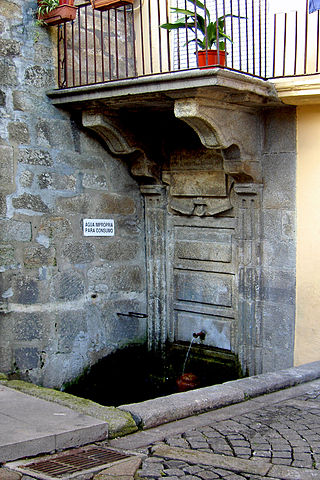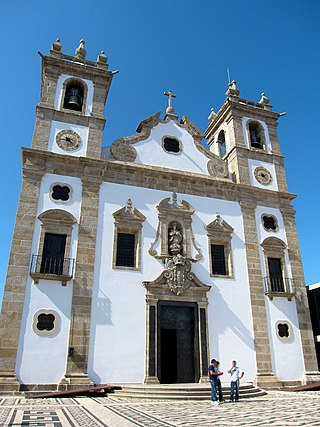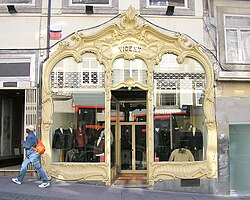
Angústias is one of the three freguesia that comprise the urban area of the city of Horta, on the island of Faial in the Portuguese archipelago of the Azores. This is an economically active, densely populated area. The population in 2011 was 2,418, in an area of 3.79 km2. Due to its commercial nature, the parish is one of the island's primary destinations for tourism, due to the concentration of historical sights and shopping. It contains the localities Caminho do Meio, Courelas, Pasteleiro, Port Pim, Termo da Igreja and Vigia.

Cachoeira is an inland municipality of Bahia, Brazil, on the Paraguaçu River. The town exports sugar, cotton, and tobacco and is a thriving commercial and industrial centre.

Nelas is a municipality located in the Centro Region of continental Portugal. The population in 2011 was 14,037, in an area of 125.71 km².

The Casa do Infante, or alternately as the Alfândega Velha, is a historical house in the civil parish of Cedofeita, Santo Ildefonso, Sé, Miragaia, São Nicolau e Vitória, in the municipality of Porto, in northern Portugal.

The Bica Funicular, sometimes known as the Elevador da Bica, is a funicular railway line in the civil parish of Misericórdia, in the municipality of Lisbon, Portugal. It connects the Rua de São Paulo with Calçada do Combro/Rua do Loreto, operated by Carris.
Avanca is a civil parish in the municipality of Estarreja, in the central subregion of Baixo Vouga. The population in 2011 was 6,189, in an area of 21.07 km2.

The Casa da Câmara is a former-administrative building located in the civil parish of Cedofeita, Santo Ildefonso, Sé, Miragaia, São Nicolau e Vitória, in the municipality of Porto, in northern Portugal.

The English Club of Porto, is the name referring to the building along Rua das Virtudes, a 14th-century manorhouse situated in the Portugueses civil parish of Cedofeita, Santo Ildefonso, Sé, Miragaia, São Nicolau e Vitória, municipality of Porto.

The Devesas Factory Warehouse is a former-warehouse used for materials in the civil parish of Cedofeita, Santo Ildefonso, Sé, Miragaia, São Nicolau e Vitória, in the municipality of Porto, in the Portuguese district of the same name.

The College of the Marists is a former-college in the civil parish of Lordelo do Ouro e Massarelos, in the municipality of Porto, in the Portuguese district of the same name.

The Palace of Freixo is a former-residence in the civil parish of Campanhã, in the northern Portuguese city of Porto.

The Palace of the Carrancas is a former-residence in the civil parish of Cedofeita, Santo Ildefonso, Sé, Miragaia, São Nicolau e Vitória, in the northern Portuguese city of Porto. It houses the Soares dos Reis National Museum.

The Residence of the Maias, is a 16th-century building situated in the Portuguese civil parish of Cedofeita, Santo Ildefonso, Sé, Miragaia, São Nicolau e Vitória, municipality of Porto, the district of the same name.

The Palacette of Belomonte is a former-residence on Rua de Belomonte, in the civil parish of Cedofeita, Santo Ildefonso, Sé, Miragaia, São Nicolau e Vitória, in the northern Portuguese city of Porto.

The Fountain of Colher, is a fountain in the civil parish of Miragaia, in the municipality of Porto, under the level of the Rua Nova da Alfândega.

The architecture of Póvoa de Varzim, in Portugal, demonstrates a broad variety of architectural styles over its thousand years of history. 11th-century Romanesque, 16th-century Mannerism, 18th-century Baroque, late 18th-century neoclassicism, early 20th-century Portuguese modernism and late 20th- to early 21st-century contemporary architectural styles and more are all represented in Póvoa de Varzim. As a whole it represents a rich eclectic tradition and innovation shaped by the people, their beliefs and economy.

The Museum-Residence of Dr. Anastácio Gonçalves is a former residential home built in the Art Nouveau style that has been converted into a museum of nineteenth-century Portuguese painting and of Art Nouveau art and artifacts. It is located in the civil parish of Avenidas Novas, in the municipality and Portuguese capital of Lisbon.

The Convent of Santo António da Cidade is a former-convent and public library in the civil parish of Bonfim, in the municipality of Porto, in the Portuguese district of the same name.

The Pillory of Lisbon is a pillory situated in the municipal square of the Portuguese capital, classified as a National Monument.

The Berardo - Art Deco Museum (B-MAD) is an Art Deco museum in Lisbon, capital of Portugal, that also displays Art Nouveau pieces that contribute to the understanding of Art Deco. It is an initiative of the Associação de Colecções, established by the Portuguese businessman, Joe Berardo. The museum opened to the public on 24 April 2021.





















